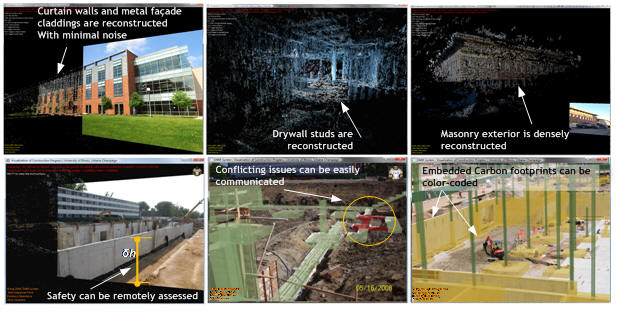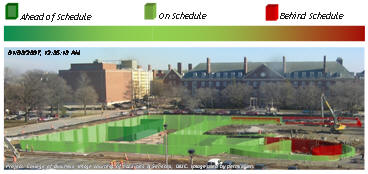Computer Vision Research Recognized at Innovation in AEC Conference
With D4AR models, you can monitor progress, productivity, safety, quality, constructability and even site logistics remotely.

 Enlarge
Enlarge
The paper, D4AR models for automated remote progress tracking and support of decision-enabling tasks in the AEC/FM industry, by Mani Golparvar-Fard, Prof Feniosky Peña-Mora (Dean of Engineering and Applied Science at Columbia University), and Prof. Silvio Savarese was awarded the Best Student Paper Award at the The 6th Int. Conference on Innovation in Architecture, Engineering and Construction.
Four-dimensional augmented reality (D4AR) models are computer-generated models of any scene that reveals a 3D model, generated by real photographs that anyone can take of the scene, to which is added the element of time.
The use of digital photos to monitor construction projects has become commonplace, thanks to inexpensive cameras, low-cost memory and Internet access on construction sites. The paper describes a new modeling technique that uses such common photos to visualize and automatically track construction progress in four dimensions, offering construction professionals a new, low-cost way to monitor projects.
Golparvar-Fard (PhD Civil Engineering and MS Computer Science, 2010, University of Illinois-UC), who was co-advised by Savarese and Peña-Mora, describes how the 4-dimensional augmented reality (D4AR) models would be generated and put to use in a construction setting:
“Imagine you are sitting at your office and you would like to conduct a walk-through on your job site, but you are miles away from the site. What you can do now is to make a phone call to your construction site, ask your superintendants and field engineers to take photos of the site and send those back to you. Using our D4AR modeling approach, you would be able to automatically reconstruct actual 3D models of the site using these photos and register the 3D model and the photos with as-designed Building Information Models (BIMs). By visualizing D4AR models, you would be able to remotely walk-through on the construction site, imagine yourself in those locations that the photos have been captured from, and study both the actual status of the project (from the photos and the actual model) and the expected status of the project (from the BIM model). In such integrated environments, you can monitor progress, productivity, safety, quality, constructability and even site logistics.”

 Enlarge
Enlarge
This technique has been extended by the same authors to generate an automated progress monitoring device that will use D4AR models to automatically measure physical progress at a work site. Several construction companies are studying the feasibility of using the system for their projects.

 Enlarge
Enlarge
Prof. Savarese, who specializes in computer vision, is conducting related research with Golparvar-Fard, Peña-Mora, and Dr. Joyce Thomas to enable first responders in chaotic and inhospitable environments to quickly maneuver around a site, collect photos, and automatically reconstruct D4AR models, leading to more efficient disaster management.
 MENU
MENU 
